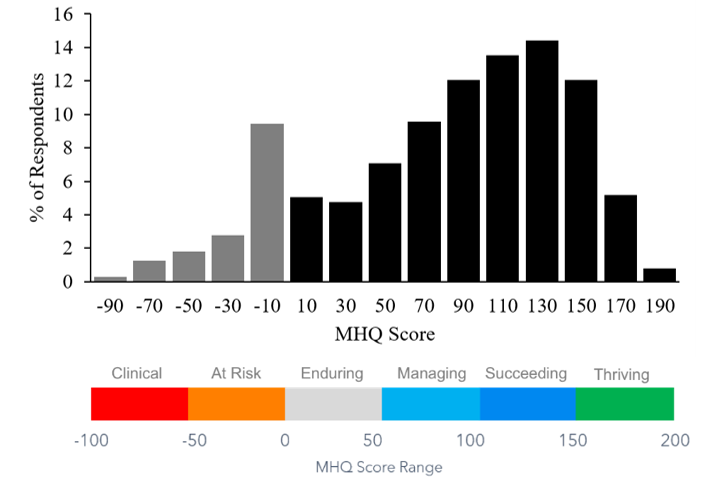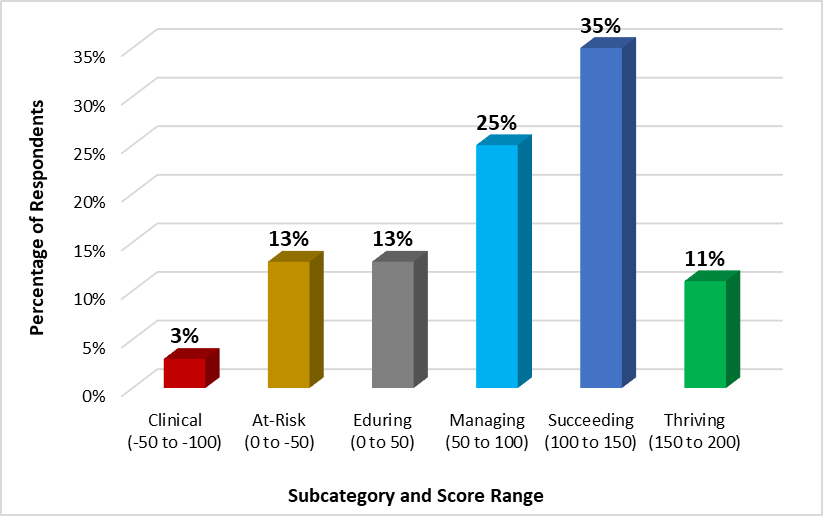The Mental Health Quotient gives us a insight into the full spectrum of mental health and wellbeing at both an individual and population level.
Most mental health researchers use data from clinical assessment tools to conduct their studies. These tools are excellent for assessing if a person has a specific mental illness, like depression or anxiety.
However, these individual diagnostic tools do not help us understand mental health in large groups of people. First, most of these tools are limited to questions about particular disorders. As a result, they do not capture all of the elements that make up a person’s mental health.
Second, clinical assessment tools do not capture the positive aspect of mental function. As the World Health Organization says, mental health is not merely the absence of mental illness. Rather, mental health is:
“…a state of wellbeing in which every individual realizes his or her own potential, can cope with the normal stresses of life,can work productively and fruitfully, and is able to make a contribution to his or her community.”
World Health Organization, 2014
If we do not ask questions about positive aspects of mental function, we cannot know what “normal” mental wellbeing looks like in individuals or communities. As a result, it is hard to understand what dysfunction actually means. Where are the borders between these two concepts?
Sapien Labs’ Mental Health Quotient is a powerful tool designed to address these data gaps. The anonymous online test, therefore, serves two purposes:
- Provides individual participants with easy-to-understand reports about their mental health status across the range of normal functioning and clinical risk
- Allows a population-level understanding of what our collective mental wellbeing looks like so we can analyze geographic and demographic differences.
Understanding the MHQ
The MHQ is based on a review of 126 mental health assessment tools, which Sapien Labs narrowed down to a list of 47 attributes that contribute to mental health and wellbeing. After completing the questionnaire, individuals receive a report that explains their MHQ scores. Individual participant scores range from -100 to 200, with lower scores indicating poorer mental health.
The scoring is based on a sophisticated scoring method that takes into consideration the relative impact of different negative symptoms. For example, if a person is at risk of suicide, this would be weighted more heavily than experiencing restlessness. Negative scores indicate the presence of or high risk for a clinical mental disorder.
Our Collective Mental Wellbeing
Right now, over 1000 people take the MHQ each week. Based on the first two thousand takers, here is what our population distribution looks like:

Like an IQ score, the average score in the normal (positive range) is 100. However, individual scores can change based on specific circumstances; a person can even receive different scores on the same day as their answers can differ slightly based on what they are feeling at the moment they take the test. Therefore the individual score may be less relevant than the broad category in which the score falls. As such, once a person completed the MHQ, their report shows them which category they fall into based on the MHQ score: Clinical, At-Risk, Enduring, Managing, Succeeding, or Thriving. Chart B shows that overall, more people were in the At-Risk and Clinical categories than the Thriving group.

The Value of the Population View
Population data, such as that collected by the Mental Health Million Project, can give us insights into our collective mental wellbeing than can shape public policy and practices in the future. For instance, as more people take the MHQ, we can begin comparing mental wellbeing scores on the local, state, and national levels. The comparisons can help us figure out what factors are influencing mental wellbeing in different areas, leading to more targeted policy interventions.
Also, population data can help us understand how global events shape mental wellbeing across the world. For instance, health experts are already concerned about the mental health impact of the coronavirus pandemic. Population data can show how the pandemic is affecting mental health of different countries and communities over time, and what factors are contributing to differences between them. This data gives decision-makers the opportunity to find mental health interventions that can be used globally and tailor responses that address the unique needs of different populations.

